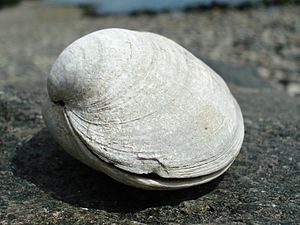Saxidomus gigantea facts for kids
Quick facts for kids Saxidomus gigantea |
|
|---|---|
 |
|
| Scientific classification | |
| Synonyms | |
|
The Saxidomus gigantea, also known as the butter clam, is a large, tasty clam that lives in the ocean. It's a type of bivalve mollusk, which means it has two shells hinged together. This clam belongs to the family Veneridae, often called the venus clams. You can find butter clams along the western coast of North America, from the Aleutian Islands all the way down to San Francisco Bay. People also call this clam the Washington clam, smooth Washington clam, or money shell.
Many old butter clam shells have been found in ancient shell piles, called middens, on Sidney Island in British Columbia, Canada. This shows that people have been eating these clams for a very long time!
Contents
What Does a Butter Clam Look Like?
This big clam can live for more than twenty years. It can grow up to 15 cm (6 in) long. Smaller clams are often almost as tall as they are long. The hinge part of the shell, called the umbo, is quite wide. The black band that connects the two shells is on the outside.
The oval-shaped shells don't have lines that spread out from the center. Instead, they have clear, raised rings that go around them. These rings are a bit like the growth rings you see on a tree. Each half of the shell has three small "teeth" inside that help the shells fit together tightly. The outside of the shell is usually white. However, it can sometimes look reddish-brown because of minerals from the sand or mud where it lives. The inside of the shell is smooth and white, but it's not shiny. It has a line called the pallial line and two equal-sized scars from the muscles that close the shell. The clam has two tubes, called siphons, that are joined together and are about 4 cm (1.6 in) long with black tips.
Where Do Butter Clams Live?
S. gigantea lives in the shallow waters of the northeastern Pacific Ocean. Its home stretches from the Bering Sea and the Aleutian Islands south to San Francisco Bay in California. However, it's not very common south of Humboldt Bay. You can find these clams buried in soft places like sand, muddy sand, or gravel. They live from the low intertidal zone (the area uncovered at low tide) down to about 40 m (130 ft) deep in the ocean.
How Butter Clams Live and Eat
This clam lives buried in soft ground, sometimes digging as deep as 35 cm (14 in) below the surface. It's a filter feeder, which means it gets its food by filtering water. When it wants to eat, it extends its siphons into the water. It then sucks in water, takes out tiny floating plants called phytoplankton and other small bits of food, and then pushes the clean water back out.
Small crabs, like the Pinnixa faba (a type of pea crab), sometimes live inside the clam's shell without harming it. This is a type of symbiotic relationship. Larger animals also like to eat butter clams. These include the Dungeness crab, the Lewis's moon snail, sunflower sea stars, mottled stars, and sea otters.
Understanding Saxitoxins in Clams
Saxitoxins are natural poisons made by tiny ocean organisms called dinoflagellates. When clams and other bivalve mollusks eat these dinoflagellates, the toxins can build up in their bodies. This process is called bioaccumulation. If people eat clams with too many of these toxins, they can get sick with something called paralytic shellfish poisoning (PSP).
The United States Food and Drug Administration (FDA) says that seafood is not safe to eat if it has more than 80 μg of PSP toxins per 100 g of seafood. Toxin levels are usually much higher in the summer months, but clams can have toxins at any time of year. Different types of seafood also carry different risks. Seafood sold in stores must meet FDA safety rules. Interestingly, sea otters and seabirds seem to be able to tell if clams have toxins and will avoid eating them.
In one case in 1993 in Kodiak, Alaska, very high levels of saxitoxin were found in blue mussels (Mytilus edulis). The levels were as high as 19,600 μg / 100 g. This was enough to be very dangerous even from a small mussel. In comparison, the highest level found in the Pacific littleneck clam (Leukoma staminea) was 580 μg / 100 g. Butter clams, however, tend to collect the most PSP toxins, with levels as high as 7,500 μg / 100 g recorded. The reason for this difference is that littleneck clams have a special chemical (an enzyme) that changes saxitoxin into a less harmful form. Blue mussels and butter clams don't have this ability.

